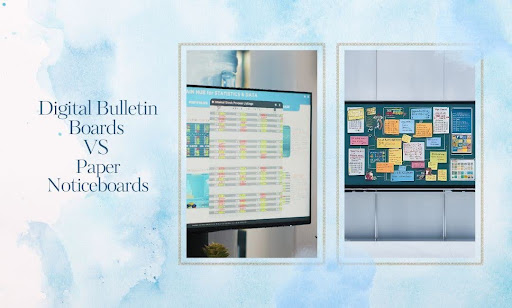What if the way we’ve been sharing updates for decades has outlived its usefulness? While traditional paper noticeboards once served their purpose, times have changed. Managing announcements, schedules, and updates today demands a smarter solution—one that saves time, reduces waste, and simplifies the way information is shared.
Funeral homes, in particular, are stepping away from paper noticeboards in favor of digital bulletin boards. Why? The reasons go beyond convenience—they reflect a need for better efficiency and a modern touch.
Let’s break it down. Paper noticeboards can feel chaotic, outdated, and labor-intensive. Notices get lost in the clutter or need constant replacements. Compare that to digital bulletin boards, which streamline updates with sleek displays, flexible scheduling, and reduced hassle. It’s no wonder funeral homes are making the change.
Here’s what this article will cover:
- A snapshot of funeral homes relying solely on paper noticeboards.
- The hidden challenges and inefficiencies of paper-based communication.
- How digital bulletin boards solve these problems with ease.
- A side-by-side comparison of digital bulletin boards and paper noticeboards.
Switching to digital doesn’t mean losing tradition—it means embracing solutions that respect both time and purpose. Stick around, and you’ll see why this upgrade is more than worth considering.
The Era of Paper Noticeboards: A Look Inside

Before the digital age reshaped communication, paper noticeboards were the backbone of many businesses, including funeral homes. These boards served as a physical hub for sharing updates, schedules, and memorial announcements. Simple and straightforward, they got the job done—until they didn’t.
In theory, paper noticeboards offered a practical solution. They were easy to set up, affordable, and allowed funeral homes to keep visitors informed. But in practice, they came with their share of challenges. Notices had to be printed, posted, and constantly replaced. Over time, clutter became unavoidable, making it harder for visitors to find the information they needed.
The Drawbacks That Added Up
Using paper noticeboards might seem cost-effective, but the inefficiencies piled up quickly. Here’s why:
- Time-Intensive Maintenance: Staff often spent hours printing, organizing, and updating announcements.
- Limited Space: A single board could only display so much. Important details often got overlooked in the crowd of overlapping notices.
- Lack of Durability: Paper is fragile. Notices would tear, fade, or simply get lost.
- Environmental Concerns: With the average office worker using 10,000 sheets of paper annually, the environmental impact of such practices became harder to ignore.
As a result, what started as a tool for efficiency often turned into a source of frustration for staff and visitors alike. The cracks in the system became increasingly visible as funeral homes grappled with modern expectations for clear and timely communication.
Paper noticeboards, once a staple, no longer felt adequate for the job. This shift paved the way for funeral homes to explore more reliable, flexible alternatives—a move that would ultimately transform the way they manage communication.
The Challenges Paper Noticeboards Can’t Overcome
At first glance, paper-based communication seems simple enough—print a notice, pin it up, and you’re done. However, the realities of relying solely on paper noticeboards reveal a host of inefficiencies that disrupt operations and impact visitors.
Funeral homes, in particular, face unique communication demands. Important updates must be timely, clear, and respectful. Unfortunately, paper-based systems often fall short, creating more problems than they solve.
- Inconsistent Messaging: Printed notices rely heavily on human oversight. Typos, outdated information, and forgotten updates are common pitfalls. When someone overlooks a detail or fails to update a board in time, visitors can be left confused or uninformed. These issues reduce the ability of a noticeboard to reach the right people effectively.
- Operational Inefficiency: Maintaining paper noticeboards takes time—a lot of it. From designing and printing to physically replacing notices, these tasks pull staff away from more critical responsibilities. A study by McKinsey highlights that employees spend an average of 1.8 hours per day searching for and gathering information, demonstrating how outdated communication methods can hinder productivity. Switching to a more advanced browser-based system eliminates these inefficiencies.
- Missed Information: When boards are overloaded with announcements, it’s easy for key messages to get buried. Visitors might skim past the most important details, leaving them without the guidance they need. With digital displays, information is better organized, ensuring great clarity for visitors.
- Environmental and Cost Impact: The cost of paper, ink, and printers adds up, especially when frequent updates are required. Beyond the financial aspect, the environmental cost is significant. For instance, according to a report, producing a ton of paper requires over 24,000 gallons of water. This highlights the need for sustainable alternatives that let funeral homes focus on the things that matter most—reducing waste while improving efficiency.
- Limited Accessibility: Paper noticeboards offer no way to share updates with individuals who can’t physically visit the location. This can create gaps in communication, particularly for family members or stakeholders who need information remotely.
- Lack of Adaptability: Every announcement must be crafted, printed, and manually added to the board. This process doesn’t allow for real-time updates or adjustments, leaving the system rigid and difficult to manage during last-minute changes or emergencies.
- Clutter and Visual Overload: Over time, paper boards can become crowded and disorganized. The visual clutter makes it harder for visitors to focus on what truly matters, leading to frustration or missed messages.
- Security Risks: Paper-based systems offer no way to safeguard sensitive or private information. If confidential details are posted publicly, they can be easily accessed or misused, exposing organizations to potential privacy concerns.
These challenges make it clear: while paper noticeboards may have been sufficient decades ago, they no longer meet the demands of a modern funeral home. The inefficiencies don’t just create extra work—they compromise the overall experience for both staff and visitors.
Digital Bulletin Boards: The Modern Solution

Digital bulletin boards are reshaping how businesses, including funeral homes, handle communication. By addressing the inefficiencies of paper noticeboards, these screens offer a practical, streamlined alternative that meets the demands of today’s fast-paced environment.
Let’s explore how digital bulletin boards solve these common challenges with ease.
- Instant Updates Without the Hassle: Digital systems allow staff to make quick updates from a central platform, eliminating the need to print and replace notices manually. This flexibility ensures that information is always accurate and up to date. According to a survey by Forrester Research, organizations using digital signage report a 20-25% reduction in manual processes, freeing up time for higher-priority tasks.
- Streamlined Messaging: Unlike cluttered paper boards, digital bulletin boards present information in an organized, visually appealing format. Announcements are displayed clearly, reducing the risk of key messages getting overlooked.
- Scalable and Customizable: Digital boards can display multiple types of content—schedules, memorial announcements, or event updates—without running out of space. They also allow businesses to tailor messages to specific audiences or locations, ensuring that every visitor sees what’s most relevant to them.
- Enhanced Accessibility: With cloud-based platforms, digital bulletin boards make it possible to manage and share information remotely. Family members or stakeholders who can’t visit the funeral home in person can still stay informed, bridging critical communication gaps.
- Eco-Friendly and Cost-Effective: Switching to digital significantly reduces the use of paper and printing supplies. Over time, the initial investment in digital technology pays off by lowering operational costs and minimizing environmental impact. The Environmental Protection Agency (EPA) reports that businesses adopting digital solutions can reduce paper consumption by up to 90%.
- Improved Visitor Experience: Digital displays create a professional and welcoming environment. Their sleek design and dynamic content capture attention, making it easier for visitors to find the information they need without frustration.
- Secure Communication: Unlike paper, digital systems offer control over what is displayed and who has access to it. This adds a layer of security, ensuring sensitive information is protected from public exposure.
By addressing these challenges, digital bulletin boards provide a reliable, modern solution for funeral homes. They don’t just replace outdated methods—they simplify communication and create a smoother experience for both staff and visitors.
Digital Bulletin Boards vs. Paper Noticeboards: A Side-by-Side Comparison
When evaluating communication tools for funeral homes, a direct comparison between digital bulletin boards and paper noticeboards highlights key differences. Below is a detailed breakdown of their functionality, efficiency, and overall impact to help you assess which option is better suited to modern needs.
| Feature | Paper Noticeboards | Digital Bulletin Boards |
| Initial Cost | $50–$200 per board, depending on size and quality. | $1,000–$3,000 per display, including hardware and software setup. |
| Annual Maintenance Cost | $500–$1,500 for paper, ink, and printer maintenance, depending on volume. | $100–$300 for software subscriptions and minor technical upkeep. |
| Update Speed | 10–30 minutes to print, post, and adjust physical notices. | 1–2 minutes to update content via a centralized dashboard. |
| Content Capacity | Limited to 5–10 notices per board before overcrowding becomes an issue. | Supports unlimited notices displayed in a rotating sequence or dynamic layout. |
| Space Requirement | Requires 6–10 square feet of wall space per board. | Occupies 1–2 square feet, with scalability to multiple screens. |
| Lifespan | Boards typically last 2–5 years, while printers require replacement every 3–7 years. | Displays last 5–10 years, with proper maintenance extending longevity. |
| Energy Consumption | Minimal, except for printing equipment which consumes 200–400 kWh annually. | Average display consumes 80–150 kWh annually per screen. |
| Environmental Impact | Produces 250–500 pounds of paper waste annually, plus ink cartridge waste. | Reduces paper waste entirely, cutting down 95–99% of associated environmental costs. |
| Cost Over 5 Years | $3,000–$6,500, accounting for ongoing expenses (paper, ink, and replacements). | $2,500–$5,000, factoring in hardware, software, and energy costs. |
Key Technical Insights
- Cost Efficiency: While paper noticeboards seem cheaper upfront, their recurring expenses make them costlier over time. Digital bulletin boards recover initial investments within 3–5 years due to reduced maintenance and material costs.
- Time Savings: Digital boards cut down update times by up to 90%, allowing staff to focus on higher-value tasks.
- Sustainability: Paper systems generate hundreds of pounds of waste annually, whereas digital solutions significantly minimize environmental impact.
These figures provide clear evidence of the technical superiority of digital bulletin boards, especially for businesses like funeral homes where precision, efficiency, and sustainability are critical.
Wrapping Up: The Smarter Way to Manage Communication
Modern challenges call for modern solutions, and the shift from paper noticeboards to digital bulletin boards is a clear example of that. By embracing digital tools, funeral homes can save time, reduce waste, and offer a seamless experience for their visitors—all while streamlining their operations.
Here’s a quick recap of what we covered:
- Traditional methods fall short: Paper noticeboards are time-consuming, prone to errors, and costly to maintain.
- Digital solutions excel: Digital bulletin boards bring flexibility, scalability, and security to communication processes.
- Cost comparisons highlight the long-term savings: While digital systems may cost more upfront, they deliver measurable benefits in efficiency and reduced recurring expenses.
- Environmental impact matters: Going digital significantly reduces waste and supports sustainability.
Making the switch to digital bulletin boards isn’t just about adopting new technology; it’s about meeting the expectations of modern communication. By taking a closer look at your current setup and evaluating the benefits of digital signage, you’re setting the stage for efficiency, clarity, and a better visitor experience.
If your funeral home is ready to embrace smarter communication tools, it’s time to explore solutions tailored to your needs. CrownTV’s digital signage options provide an intuitive, powerful way to upgrade your space—because simplifying communication should never be complicated.
What You Gain with CrownTV’s Digital Signage Solutions
- End-to-End Solutions for Every Step: From selecting top-quality displays suited to your space to seamless installation and setup, CrownTV simplifies the process, allowing you to manage content from anywhere, anytime.
- Streamlined Content Management: Take control with our cloud-based dashboard, designed for effortless updates and adjustments, no matter how many screens you oversee.
- Expert Planning and Execution: We handle every detail, from site assessments to installation, ensuring your system meets professional standards and integrates perfectly into your environment.
- App Integrations That Work for You: Access hundreds of apps and widgets, tailored to your specific needs, to create dynamic, engaging displays that resonate with your audience.
- More Than a Decade of Experience: With over 13 years in the digital signage industry, CrownTV brings unmatched expertise to optimize communication and engagement for your funeral home.
- Reliable Support and Maintenance: Our dedicated team is always ready to assist with troubleshooting or updates, ensuring your system remains efficient and effective.
- A Powerful Media Player: CrownTV’s media player delivers consistent, high-quality performance for managing and displaying all your content seamlessly.
- Nationwide Installation by Professionals: Certified technicians across all 50 states ensure smooth installations, handling everything from cabling to system testing.
With CrownTV’s cutting-edge tools and industry expertise, you’ll achieve a smarter, more efficient communication system—one that’s tailored to meet the evolving needs of funeral homes.

